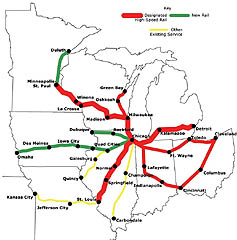
Brenda Konkel’s recent blog entry on high speed rail began with a rhetorically asked “What’s so scary about a train?” That question deserves to be asked seriously because within the answer lies the path forward for those who want to see rail transportation projects of all types survive and thrive in Wisconsin. So here goes!
I have been monitoring talk radio’s spin on the RTA and High Speed Rail since 2007. If you have too you probably have noticed that most of the same core criticisms of rail apply equally deservingly to highways. There are a lot to choose from but I will focus on one of the criticisms that cannot be applied as readily to highways:
“Very few people will ever use it”
If this is true, it is indeed scary, since all the benefits of a rail project vanish if there are no passengers. In order to address this valid concern, what is needed is an explanation of why large numbers of people will ride the train. Have you heard this explanation in a public forum? In the media? I have not.
Without a readily available and acceptable explanation of why large numbers of people will ride the train, people are left to evaluate that question based on personal experience. Most Wisconsinites, having no experience using trains on a regular basis are not going to be able to come up with a reason to ride a train because they are driving everywhere today.
And there you have it: People are afraid of trains because they cannot see why they or anybody else would use it. Now what should rail proponents do with this information?








Here’s my problem… because of the budget shortfall that came to light after Tommy Thompson left for Washington, this state is in a heckuva predicament, financially. To make matters even worse, voters in the state got incredibly STUPID and elected quite possibly THE WORST Republican candidate EVER as governor. Make no mistake, Walker is going to gut every single thing he can think of, so why are we spending money on something that REALLY should NOT be a priority right now???
I understand our hands are kinda tied by the bureaucrats in Washington and the stimulus money, but there ARE better things to use the stimulus money for than a train RIGHT NOW.
Just sayin’…
Cory,
There’s a missing link in your argument. Can you tell me why HSR is not something we should be spending money on right now?
Would it be interesting if it could be a car ferry train?!? The part that I see as making it less likely to be used is that (many) people want the convenience of a car at each end. If it were possible to load their car up, would they be more likely to use it? I know it would be a logistical nightmare, but I’m willing to plant the thought anyway. Same question for bikes, tho that may be more of a given.
I think Dorothy is on to something, but if you substitute “efficient public transit at each end” for “a car at each end,” things look different. Then we are back to the initial point that most Wisconsinites don’t have experience with efficient public transit, be it train or bus. The problem is that you can’t change people’s assumptions and habits with the abstract promise of “efficient public transit” you have to provide it so that they can gain the experience and see the advantages. That of course requires investments and there will be a lag time before the investments pay off in ridership.
Cory,
At some point we have to plan for the future. We have been putting off building and maintaining infrastructure projects for too long, and all this cutting does not put any noticeable extra money in your wallet.
I know that I want to see HSR in this state for my potential use. This is a system that hooks us not just to a few cities, but also to larger rail transit locations.
The assumption that all Wisconsinites that currently drive will always wish to drive feels short sighted and overly generalized. HSR offers alternative travel to skyrocketing airfair and limited bus travel, as well as new transit opportunities for outlying communities.
I respect people’s concerns about the cost of a project like this, but this is money being spent on job creation, the development of our state infrastructure, and providing new commercial opportunities. We need to stop rolling stimulus money into administrative ventures and trickle-down theories, and instead apply it to projects that actually build something for our future.
As the price of oil gets higher, mass transit alternatives look ever more enticing. Where mass transit is a real option, ridership went way up when gas hit $4/gal. Increasingly, mainstream estimates expect oil production to peak and begin to decline in the next 10-20 years (if it hasn’t happened already). The time to build alternatives is now, not later. Otherwise, there will be no alternative.